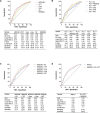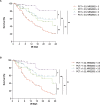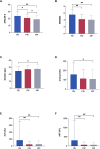Nutritional risk factors for all-cause mortality of critically ill patients: a retrospective cohort study
- PMID: 36396305
- PMCID: PMC9677028
- DOI: 10.1136/bmjopen-2022-066015
Nutritional risk factors for all-cause mortality of critically ill patients: a retrospective cohort study
Abstract
Objectives: This study aimed to explore the predictive value of single and multiple risk factors for the clinical outcomes of critically ill patients receiving enteral nutrition and to establish an effective evaluation model.
Design: Retrospective cohort study.
Setting: Data from the 2020-2021 period were collected from the electronic records of the First Affiliated Hospital, Nanjing Medical University.
Participants: 459 critically ill patients with enteral nutrition in the geriatric intensive care unit were included in the study.
Primary and secondary outcome measures: The primary outcome was 28-day mortality. The secondary outcomes were 28-day invasive mechanical ventilation time, intensive care unit stay, Nutrition Risk Screening 2002 (NRS2002) score and Acute Physiology and Chronic Health Evaluation II (APACHE II) score.
Results: Independent prognostic factors, including prealbumin/procalcitonin (PCT) ratio and APACHE II score, were identified using a logistic regression model and used in the nomogram. The area under the receiver operating characteristic curve and concordance index indicated that the predictive capacity of the model was 0.753. Moreover, both the prealbumin/PCT ratio and the combination model of PCT, prealbumin and NRS2002 had a higher predictive value for clinical outcomes. Subgroup analysis also identified that a higher inflammatory state (PCT >0.5 ng/mL) and major nutritional risk (NRS2002 >3) led to worse clinical outcomes. In addition, patients on whole protein formulae bore less nutritional risk than those on short peptide formulae.
Conclusions: This nomogram had a good predictive value for 28-day mortality in critically ill patients receiving enteral nutrition. Both the prealbumin/PCT ratio and the combination model (PCT, prealbumin and NRS2002), as composite models of inflammation and nutrition, could better predict the prognosis of critically ill patients.
Keywords: Adult intensive & critical care; INTENSIVE & CRITICAL CARE; NUTRITION & DIETETICS; Nutritional support.
© Author(s) (or their employer(s)) 2022. Re-use permitted under CC BY-NC. No commercial re-use. See rights and permissions. Published by BMJ.
Conflict of interest statement
Competing interests: None declared.
Figures







Similar articles
-
[The prognostic value of serum procalcitonin on severity of illness in non-sepsis critically ill patients].Zhonghua Wei Zhong Bing Ji Jiu Yi Xue. 2016 Aug;28(8):688-93. doi: 10.3760/cma.j.issn.2095-4352.2016.08.004. Zhonghua Wei Zhong Bing Ji Jiu Yi Xue. 2016. PMID: 27434557 Chinese.
-
[Combined prognostic value of serum lactic acid, procalcitonin and severity score for short-term prognosis of septic shock patients].Zhonghua Wei Zhong Bing Ji Jiu Yi Xue. 2021 Mar;33(3):281-285. doi: 10.3760/cma.j.cn121430-20201113-00715. Zhonghua Wei Zhong Bing Ji Jiu Yi Xue. 2021. PMID: 33834968 Chinese.
-
[Analysis of prognosis risk factors of critically ill patients after cardiac surgery: a consecutive 5-year retrospective study].Zhonghua Wei Zhong Bing Ji Jiu Yi Xue. 2019 Jul;31(7):873-877. doi: 10.3760/cma.j.issn.2095-4352.2019.07.015. Zhonghua Wei Zhong Bing Ji Jiu Yi Xue. 2019. PMID: 31441413 Chinese.
-
[Comparison of four early warning scores in predicting the prognosis of critically ill patients in secondary hospitals].Zhonghua Wei Zhong Bing Ji Jiu Yi Xue. 2023 Oct;35(10):1093-1098. doi: 10.3760/cma.j.cn121430-20230614-00441. Zhonghua Wei Zhong Bing Ji Jiu Yi Xue. 2023. PMID: 37873716 Chinese.
-
ICU 'Magic Numbers': The Role of Biomarkers in Supporting Clinical Decision-Making.Diagnostics (Basel). 2025 Apr 11;15(8):975. doi: 10.3390/diagnostics15080975. Diagnostics (Basel). 2025. PMID: 40310334 Free PMC article. Review.
Cited by
-
Ratio of procalcitonin/Simpson's dominance index predicted the short-term prognosis of patients with severe bacterial pneumonia.Front Cell Infect Microbiol. 2023 Jul 3;13:1175747. doi: 10.3389/fcimb.2023.1175747. eCollection 2023. Front Cell Infect Microbiol. 2023. PMID: 37465762 Free PMC article.
References
Publication types
MeSH terms
Substances
LinkOut - more resources
Full Text Sources
Research Materials
